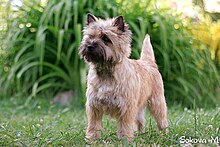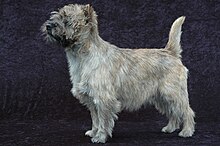| Revision as of 07:30, 18 May 2023 editInternetArchiveBot (talk | contribs)Bots, Pending changes reviewers5,382,172 edits Rescuing 1 sources and tagging 0 as dead.) #IABot (v2.0.9.4) (Eastmain - 13832← Previous edit | Revision as of 15:43, 29 November 2023 edit undo91.80.93.219 (talk)No edit summaryTags: Visual edit Mobile edit Mobile web editNext edit → | ||
| Line 18: | Line 18: | ||
| | kc_std = https://www.thekennelclub.org.uk/breed-standards/terrier/cairn-terrier/ | | kc_std = https://www.thekennelclub.org.uk/breed-standards/terrier/cairn-terrier/ | ||
| | fcistd = http://www.fci.be/Nomenclature/Standards/004g03-en.pdf | | fcistd = http://www.fci.be/Nomenclature/Standards/004g03-en.pdf | ||
| }}<!-- End Infobox Dogbreed info. Article Begins Here --> | }}<!-- End Infobox Dogbreed info. Article Begins Here. Please use British English in this article. --> | ||
| The '''Cairn Terrier''' is a ] breed originating in the ] and |
The '''Cairn Terrier''' is a ] breed originating in the ] and recognised as one of Scotland's earliest ]s. | ||
| The name “Cairn Terrier” was a compromise suggestion when the breed was brought to official shows in the United Kingdom in 1909, initially under the name “Short-haired Skye terrier”. This name was not accepted by The Kennel Club when faced with opposition from breeders of the ]. The alternative name Cairn Terrier was adopted. | The name “Cairn Terrier” was a compromise suggestion when the breed was brought to official shows in the United Kingdom in 1909, initially under the name “Short-haired Skye terrier”. This name was not accepted by The Kennel Club when faced with opposition from breeders of the ]. The alternative name Cairn Terrier was adopted. | ||
Revision as of 15:43, 29 November 2023
Scottish dog breed| This article needs additional citations for verification. Please help improve this article by adding citations to reliable sources. Unsourced material may be challenged and removed. Find sources: "Cairn Terrier" – news · newspapers · books · scholar · JSTOR (November 2020) (Learn how and when to remove this message) |
| Cairn Terrier | |||||||||||||||||||||
|---|---|---|---|---|---|---|---|---|---|---|---|---|---|---|---|---|---|---|---|---|---|
 Two Cairn Terriers showing variations in coat colour Two Cairn Terriers showing variations in coat colour | |||||||||||||||||||||
| Origin | Scotland | ||||||||||||||||||||
| |||||||||||||||||||||
| |||||||||||||||||||||
| Dog (domestic dog) | |||||||||||||||||||||
The Cairn Terrier is a terrier breed originating in the Scottish Highlands and recognised as one of Scotland's earliest working dogs.
The name “Cairn Terrier” was a compromise suggestion when the breed was brought to official shows in the United Kingdom in 1909, initially under the name “Short-haired Skye terrier”. This name was not accepted by The Kennel Club when faced with opposition from breeders of the Skye Terrier. The alternative name Cairn Terrier was adopted.
History
Cairn terriers originated in the Scottish Highlands and the Isle of Skye, initially grouped in the "Skye Terrier" class alongside the Scottish and West Highland White Terriers. From the early 1900s, the three were bred separately.
The Kennel Club of the United Kingdom gave the Cairn Terrier a separate register in 1912; the first year of recognition, 134 were registered, and the breed was given Championship status.
Description



The Cairn Terrier has a harsh weather-resistant outer coat that can be black, cream, wheaten, red, sandy, gray, or brindled. Pure black, black and tan, and white are not permitted by many kennel clubs. While registration of white Cairns was once permitted, after 1917, the American Kennel Club required them to be registered as West Highland White Terriers. A notable characteristic of Cairns is that brindled Cairns frequently change colour throughout their lifetimes. It is not uncommon for a brindled Cairn to become progressively more black or silver as it ages. The Cairn is double-coated, with a soft, dense undercoat and a harsh outer coat. A well-groomed Cairn has a rough-and-ready appearance, free of artifice. The Cairn Terrier was registered into the American Kennel Club in 1903.

Cairn Terriers tend to look similar to Norwich Terriers, but with some differences (for example the shaggy fur). The outer layer of fur is shaggy, but they have a soft, downy undercoat. The ideal weight is 4.5-7.3 kg (10-16 lb), and the height 9–13 in (23–33 cm).
Health
These dogs are generally healthy and live on average about 12 to 17 years.
Some of the more common hereditary health problems found in the Cairn are:
- Bronchoesophageal fistula
- Cataracts
- Corneal dystrophy
- Craniomandibular osteopathy (lion jaw)
- Diabetes mellitus
- Entropion
- Hip dysplasia
- Hypothyroidism
- Krabbe disease (globoid cell leukodystrophy)
- Legg–Calvé–Perthes disease
- Lens luxation
- Luxating patella
- Ocular melanosis
- Portosystemic shunt
- Progressive retinal atrophy
- Soft-tissue sarcoma
- Von Willebrand disease
References
- "Cairn Terrier History". American Kennel Club. Retrieved 26 October 2014.
- "swwectc- cairn history". www.swwectc.freeuk.com. Archived from the original on 2018-10-18. Retrieved 2016-11-26.
- "Individual Breed Results for Purebred Dog Health Survey". Archived from the original on 2007-05-04. Retrieved 2012-06-26.
- Leroy, G. G.; Phocas, F.; Hedan, B.; Verrier, E.; Rognon, X. (2015). "Inbreeding impact on litter size and survival in selected canine breeds" (PDF). The Veterinary Journal. 203 (1): 74–8. doi:10.1016/j.tvjl.2014.11.008. PMID 25475165. S2CID 27631883. mean=12.23 ± 4.18 median=13.42
- "Health Related Concerns". Cairn Terrier Club of America Inc. Archived from the original on 7 May 2010. Retrieved 12 May 2010.
- Alex., Gough (2004). Breed predispositions to disease in dogs and cats. Thomas, Alison, 1964–. Oxford, UK: Blackwell Pub. ISBN 978-1405107488. OCLC 53231203.
| Dogs originating in the United Kingdom | |||||||
|---|---|---|---|---|---|---|---|
| Hounds | |||||||
| Gun dogs | |||||||
| Terriers |
| ||||||
| Herding dogs | |||||||
| Other | |||||||
| Extinct |
| ||||||
| |||||||
| Scottish domestic animal breeds | |
|---|---|
| |
| Cattle | |
| Dogs | |
| Horses | |
| Pigs | |
| Poultry | |
| Sheep | |